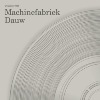Machinefabriek, "Dauw"
 Rutger Zuydervelt's ever-prolific Machinefabriek has another new album this year, one that finds him incorporating a turntable into his hushed, sparse aesthetic alongside small melodies on guitar and piano. This, as well as other seemingly incidental sounds, gives the album much of its uniqueness.
Rutger Zuydervelt's ever-prolific Machinefabriek has another new album this year, one that finds him incorporating a turntable into his hushed, sparse aesthetic alongside small melodies on guitar and piano. This, as well as other seemingly incidental sounds, gives the album much of its uniqueness.
The turntable comes through most noticeably as the crackle and sputter found on old records, and sometimes its addition backfires by being distracting or even annoying. On "Engineer," it's used so prominently that it overshadows much of the delicate feedback before low end rumbles, guitar, and cymbals replace it. By the time this happens, however, the crackling has nearly ruined the track. There were some other sounds on the album that irked me, especially in the first few minutes of "Porselein." It begins with the plucking of a fragile melody on acoustic guitar, but unidentified clunks and static make it sound like a live sound check during which someone is fixing something or stumbling in the background. Other things that sound like microphone pops or short circuits in the wiring also give the track unnecessary blemishes. The bright drones and rhythmic clicking that appear later are nice but don't quite salvage the track.
Yet sometimes the incidental sounds work well. "Fonograaf" begins with an angelic motif that's aged by the crackling vinyl noise, as if it's some mysterious record by an unknown and forgotten composer found in a dusty attic. Its ending suggests a dying beauty as the melody fades and the crackle remains constant, broken up by a thunderstorm or a magnified and drawn out sample of the needle being clumsily withdrawn. Also excellent is the title track which begins as a crisp guitar melody but transforms into an eerily moving ghostly chorus by its end.
All of these devices are used in the album's fantastic epic closer "Singel," the basic track of which was recorded live earlier this year. It starts with a quiet hum and slight crackle before introducing minimal guitar pitches, slowly building into a noisier field with more incidental sounds appearing. The track continually grows in presence and power until it slowly fades into a quiet hum and crackle like it started, ending the album's strongest track symmetrically.
While I didn't like everything on Dauw equally, the good far outweighs the bad. Beautiful and sometimes even haunting, the better tracks could be artifacts of a lost time recently rediscovered.
samples:



